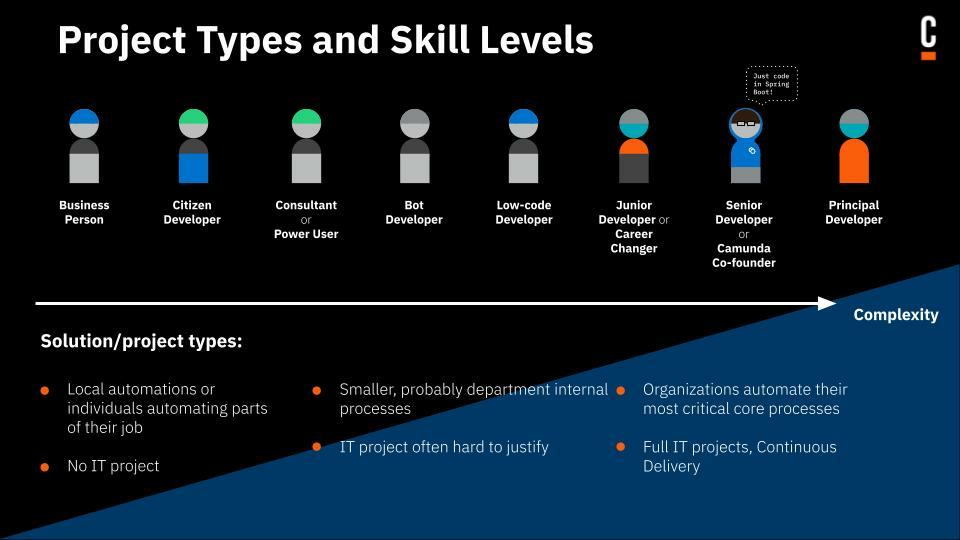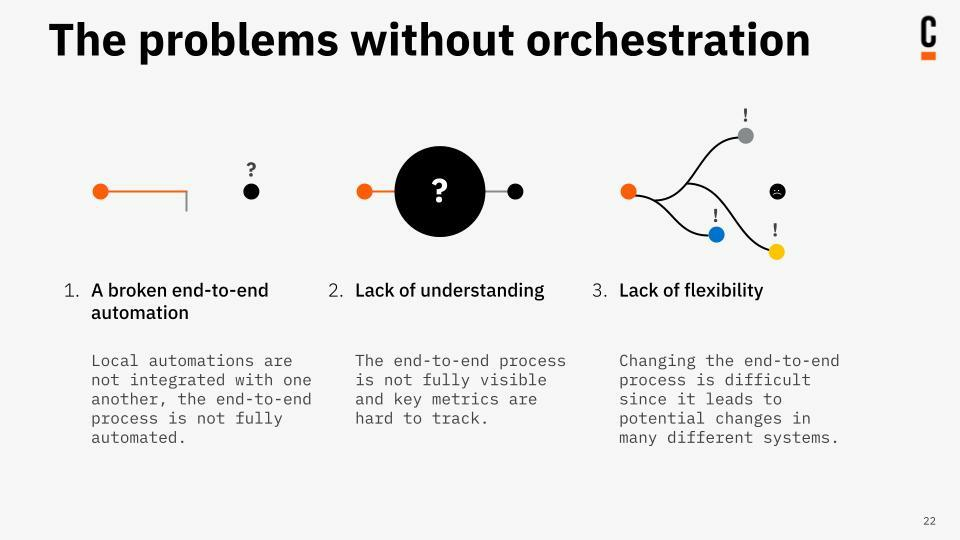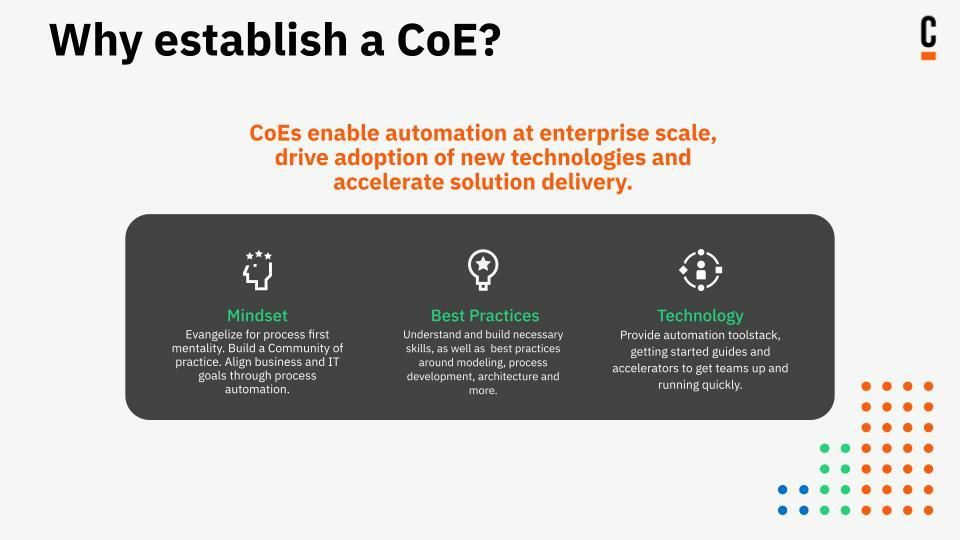Learn what you need to know to make 2023 the year of process improvement. In this webinar recap, we look back at 2022 and ahead at the key trends coming next year.
As 2022 draws to a close, we have been reflecting on the past year and thinking about what’s coming in 2023. To help stir our minds, we recently hosted a webinar called New Year, New Automation Projects: How to Make 2023 the Year of Process Improvement. This was a great discussion on the current state of process orchestration and what we all need to be thinking about as the calendar flips to 2023.
The webinar was led by Camunda Chief Technologist and Co-Founder, Bernd Ruecker, as well as David Cushman, Practice Leader at HFS Research, Niall Deehan, Developer Advocate at Camunda and Leon Strauch, Senior Customer Success Manager at Camunda. Amy Johnston, Principal Product Marketing Manager at Camunda, moderated the panel.
There were a lot of great insights surfaced by this expert panel. If you want to watch the panel, you can find the recording at the link below. Otherwise, let’s dive in.
The world of 2022 – what’s happening now?
Economic headwinds and embracing automation
2022 has been a whirlwind of a year (again), and organizations have had to face significant economic challenges. David shared data from HFS Research that showed many business leaders are citing ongoing inflation and supply chain disruptions as two of their top three macro-environmental concerns, not to mention fears of a looming recession in many economies.
As a result, while leaders cite many important priorities such as security and Environmental/Social/Governance (ESG) along with digital modernization, HFS Research data indicated that the top two areas of investment were in improving automation and leveraging emerging new technologies. But there’s a problem here – HFS Research also found that over two thirds of enterprises self-rated themselves as “automation beginners,” with a mere 9% rating themselves as “automation champions.”
Getting started with automation quickly
In this climate of cost pressure from rising interest rates, Leon explained, IT leaders agree that investing in emerging automation technology is key to not only survive the recession but emerge stronger from it (just look at the stock price of Amazon, which Leon calls a “lighthouse for digital transformation at scale,” since the last major recession in 2008!). But with money getting more expensive, it is crucial that automation leaders paint a clear picture of the value you will generate and how you will get there.
Bernd was quick to double down on agility. “Now is not the time for the big digitalization programs that will do big things 2-3 years down the road – it’s really the time to deliver very quickly.” The best way to start is to find a pain point, harvest the value, “show and tell” about it and then keep building. This is great advice for everyone, but especially for those “automation” beginners out there who are wondering how to get started.
Talent shortages and new ways of thinking
Another significant issue facing businesses today is a talent shortage. A combination of the trends that commonly get referred to as “the great resignation” and “quiet quitting” mean that getting the right people in place on your teams is no easy thing. David shared a lot of compelling data from HFS Research that show the significant challenges of keeping employees engaged and committed to sticking around long term.
Crucially, he also showed that most employees are passionate about the IT industry, and framed this as not just a challenge but an opportunity. This is the time to “transform processes” and not try to run things the way you did before. It’s just not possible to stay the same, so it’s time to adapt.
Take advantage of your existing automation talent
Companies often struggle to attract the right talent to build their automation projects, and Bernd noted that this – along with using tooling that isn’t designed with developers’ needs in mind – is a real issue.
But who is really needed to build an automation solution today? Low-code and Pro-code solutions used to be very polarized, but today, it’s not so simple.

Years ago, you either “had developers or you didn’t,” but today there is a lot more room in the middle in terms of the skills people have and the projects they are able to take on. After all, you can’t assign a Senior Developer to every project, and fortunately you don’t need to anymore.
Leon seconded this point. Customers he speaks with want to expand adoption of automation to more and more stakeholders beyond developers. It’s a trend he expects to continue. This will let organizations do more with the talent they already have and relieve pressure on IT departments.
A pro-code low-code collaboration
It’s not just developers working on the complex automation solutions and business users relegated to quirky side projects. Niall pointed out how today with new capabilities such as Connectors in tooling like Camunda, more stakeholders can be involved in creating and maintaining critical automation infrastructure. In the past, the team building a Camunda solution might have been entirely professional developers, but today, non-developers can easily design the processes while pro developers maintain the business logic. “It’s a nice separation of responsibility and it allows you to hire better,” Niall noted.
Upskilling your talent
Employees want to be challenged. That was clear from David’s data and Leon hammered this home as well. He surfaced a comment from the chat about how you can look into training your current employees to do citizen development work or Center of Excellence work. By giving more people access to automation tooling, even if they’re not developers, they will have more of a stake in digital transformation and automation initiatives and become a part of the overall transformation of the organization.
The world of 2023 – what is coming?
Process orchestration will grow in importance
Process automation means different things to different people, and Bernd drew a helpful distinction between “task automation” (doing a single task, say with RPA) and “how do those tasks happen and in what order,” which is process orchestration. Process orchestration can even be done with a 100% manual process.
Process orchestration can help you understand how your processes work, to identify what is working and what is a bottleneck, and to evolve it (say by gradually replacing manual tasks with automated ones). Without process orchestration, silos develop, and the end-to-end process is difficult to untangle, making iterative growth challenging.

Human workflow and system orchestration converge
Knowing when to involve people and when something can be automated can be tricky. Niall pointed out that not long ago, the tools for managing human workflows (who should be involved when) and technical workflows (is every system online and working correctly) were entirely different. But that is changing.
Today organizations are looking for a tool that can do both – orchestrate a distributed system and also involve users. Niall shared his belief that a focus on understanding how to integrate these two ideas will be an important trend of 2023. For this, it’s critical to have both a clear understanding of when a human is needed, and tooling that lets you easily swap out a manual task for an automated task. Bottom line? “Treat a human workflow like you would treat a microservice.”
Lots of great discussion followed about the best way to keep your employees happy as you incorporate human workflow orchestration, and balancing efficiency with effectiveness.
Automation Centers of Excellence will become more common
Centers of Excellence (CoE) aren’t a new concept – they are a cross-functional team tasked with bringing automation to the wider enterprise. Leon shared that he has been seeing a lot of interest from companies that want to establish their own CoE, and he believes they will proliferate widely in 2023.

An evolution in Centers of Excellence
Leon also predicted that CoEs will “decentralize.” This means you still have a centralized CoE that provides guidance and best practices, but that solutions will be implemented “on the ground” with agile teams throughout an organization.
Want to learn more about establishing an automation Center of Excellence? Be sure to check out this panel conversation from CamundaCon 2022, and this extended Q&A on CoE that came from it.
What do you think?
What do you think are the big trends coming to process orchestration and automation in 2023? Let us know on Twitter, LinkedIn or wherever you follow Camunda – we want to hear!
Wishing you all a happy new year and a great 2023!

